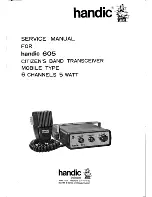
Page 24
Field Marshall Tracking Receiver
Polarization
Radio waves are electromagnetic, exactly the same as light.
When your animal is lost you’re literally seeing it, with different
eyes. The miracle is that the transmitters used in telemetry emit
such small power, a few thousandths of a watt. Picking up that
tiny signal is equivalent to seeing a dim, blinking flashlight miles
away in daylight. Listening to your receiver is like looking
through a telescope: you can look but one direction at a time,
but your visibility is high.
You know from using sunglasses that sunlight is somewhat po-
larized. Radio waves are strongly polarized. Polarization has to
do with the alignment of the magnetic and electric fields that
make up the wave. When the transmitter antenna is vertical we
say the waves are vertically polarized, and when it’s laying on
its side they are horizontally polarized.
The thing to remember is that your receiving antenna should be
oriented the same way as your transmitter antenna. This is im-
portant with weak signals. Your antenna will work poorly if it’s
oriented the wrong way, as much as ten times worse. The best
orientation could be somewhere between vertical and horizon-
tal, maybe at 60º from horizontal.
Rule #1:
When tracking a weak signal, always try rotat-
ing the orientation by 180 degrees. Stay with the orienta-
tion that gives the strongest signal. This cannot be empha-
sized strongly enough. It is easy to develop a preference for
which way to hold your antenna, but in doing so you will miss
the boat half the time. Try them both and remember that your
target can change positions at any time.
The yagi antenna’s directionality is somewhat sharper if you
hold it horizontally, so you’ll want to use this orientation when-
ever you have a strong signal.
Radiation from the end of the transmitter antenna (around the
hole of the donut) has elements of both vertical and horizontal
polarization. And after a signal has been reflected it loses its
polarization altogether. The same loss of polarization can occur
after the wave travels through obstacles.
Содержание Field 4000
Страница 1: ...Page 1 Owner s Manual OWNER S GUIDE...
Страница 15: ...Page 15 Owner s Manual...
Страница 21: ...Page 21 Owner s Manual...
Страница 22: ...Page 22 Field Marshall Tracking Receiver...
Страница 37: ...Page 37 Owner s Manual...
Страница 38: ...Page 38 Field Marshall Tracking Receiver...
Страница 40: ...Page 40 Field Marshall Tracking Receiver 800 729 7123 801 936 9000 www marshallradio com...
















































